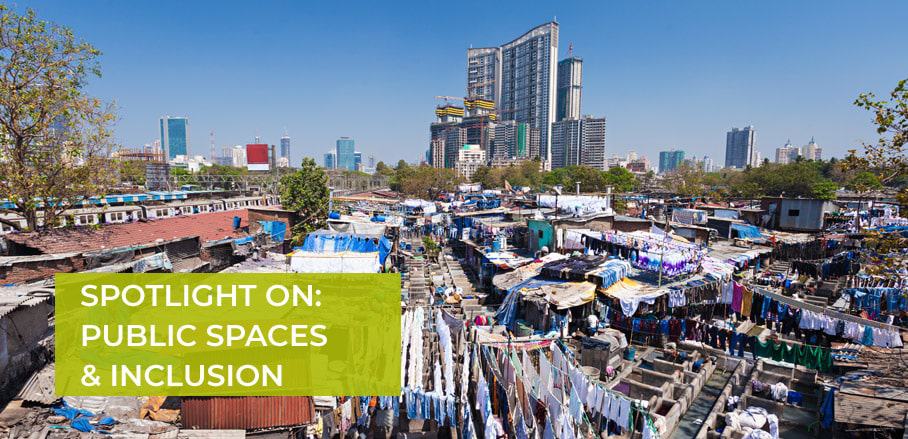Severing Mumbai’s Slums: Structural Violence Through Spatial Transformation
By Lalitha Kamath and Himanshu Burte
Almost half of Mumbai’s 12 million inhabitants live in informal settlements—“slums”—that are diverse and vibrant living and working spaces. Though unofficially nurtured by the city, these settlements are officially treated as illegal. Today, Mumbai’s state is radically transforming the city through market-led slum redevelopment. Lalitha Kamath and Himanshu Burte argue that the government is inflicting structural violence on the city’s slum dwellers by reshaping Mumbai’s physical space.
Almost half of Mumbai’s 12 million inhabitants live in informal settlements— “slums”—that are very diverse and vibrant living and working spaces. These settlements have been unofficially nurtured by the city government, although they are officially treated as illegal. Today, these living spaces are under threat, as Mumbai’s neoliberal regime seeks to radically transform it into a “world class” city through state-led initiatives including slum redevelopment. To understand the structural nature of the violence linked to the city’s global aspirations, we need to understand the role played by the state as both part of the structure organising social life and an agent of violence toward slum communities.
Structural violence is enacted through spatial transformation
According to John Galtung, structural violence is “the violence built into the structure and shows up as unequal power and consequently as unequal life chances.” Structural violence manifests not as acute bodily injury, but as long-term outcomes that directly oppress people and social groups: poor health and well-being, downward economic trajectories, and cultural deprivation. Structural violence is historically instituted and invisible; it may not be explicitly violent or have an identifiable source. Instead, it may be caused by the way institutions, laws, relationships, or social practices are organised—and thus it is harder to resist than visible physical violence, even though it often leads to more direct and conventional forms of violence.
[inlinetweet prefix=”” tweeter=”urbanet_info” suffix=””]The government has reshaped Mumbai’s physical space directly through infrastructure projects and indirectly through slum redevelopment policies[/inlinetweet]. The city’s road projects—including new roads, flyovers, a sea-link bridge—have made it easier to drive around the region. But the roads have also displaced people, pushing them into newly created ghettos in the city’s poorly connected corners. The new Jogeshwari Vikhroli Link Road, for example, severed slum neighbourhoods and destroyed viable informal communities built at great cost by poor residents. Even though the project was governed by the most progressive urban Resettlement and Rehabilitation policy in the country, most of the formally resettled households have been severely disrupted, and many have returned to informal settlements, unable to afford the maintenance costs of supposedly “free”’ resettlement housing.
The exceptional slum: Justifying forced redevelopment
Mumbai treats slums as exceptional spaces, using its sovereign power to suspend the laws of normal functioning by claiming extraordinary circumstances. This use of state power is a form of structural violence. Ultimately, the state seeks to bring these hitherto impenetrable areas under its control and generate new value for the real estate market.
First, [inlinetweet prefix=”” tweeter=”urbanet_info” suffix=””]the state produces informal settlements by defining slums as illegal, justifying the abdication of its responsibility to provide services and improve the lives and chances of the people who live there[/inlinetweet]. Slums have historically received very low levels of public investment and continue to be denied basic services. This lack of services facilitates further structural and direct violence, creating conditions that allow middlemen or gangs to fill the gap and provide the missing services (housing, water, documentation) but in unequal and exploitative ways. The middlemen’s authority over slums is cemented through collusive relationships with government agents such as local councillors or municipal staff.
Second, [inlinetweet prefix=”” tweeter=”urbanet_info” suffix=””]slums are stigmatised as a problem by officially defining them as spaces of low morality and high crime, whose settlement is founded on encroachment[/inlinetweet]. These extraordinary circumstances justify forced redevelopment to restore order and promote planned development.
State-enabled redevelopment commodifies the valuable land that slums occupy. The city-wide policy of market-led redevelopment introduced in 1991 covers all of the city’s slums. Planning codes have been relaxed to incentivise developers to develop slum land by building multi-storey buildings and selling for-profit apartments—and part 0f the profit then subsidises resettlement towers for slum-dwellers. The government grants exceptions to development control regulations by allowing private (re)developers to pack slum dwellers into overcrowded towers with little light and ventilation in a corner of the original plot—thus releasing more land for for-profit apartments.
Overall, this policy displaces people, who are forced to live for long periods in transit housing, cope with worsened health outcomes, and pay increased maintenance expenditures imposed by the new vertical slums. It has affected different poor communities, with the most vulnerable—the homeless and tenants—being most affected. In addition to the actual redevelopment programs, [inlinetweet prefix=”” tweeter=”urbanet_info” suffix=””]the city’s policies have generated real estate speculation and uneven development that pit poor communities against each other and force growing numbers to live precariously and amidst violence[/inlinetweet].
Put people above market
Mumbai’s government is enabling the market, but weakening the life chances of its poorest residents. This needs to change: at a minimum, it must “do no harm” to the majority of the urban population. More specifically, the city should reject market-led redevelopment, which has proven to be a violent policy in addressing informal settlements. More broadly, the government needs to shed its colonial-origin attitudes that stigmatise informal settlements and instead improve poor dwellers’ existing living spaces and capabilities in line with their own aspirations. But the city is unlikely to do this on its own. The collective engagement of coalitions of community leaders, advocacy groups, urban planners, and politicians need to pressure the government to choose the right course—away from structural violence and towards structural support for its most vulnerable citizens.
